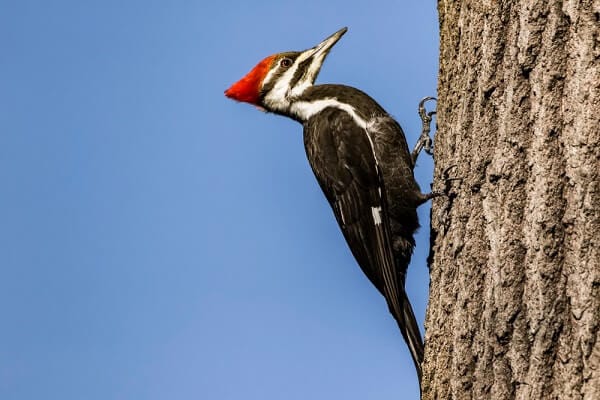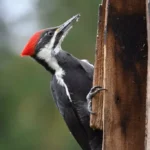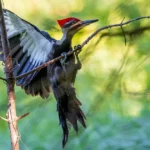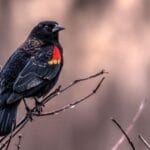Get ready to meet the Pileated Woodpecker, a feathered beauty aptly nicknamed the “Lord of the Forest.” From its striking red crest to its impressive wingspan, this bird is a sight to behold. But beyond its good looks, the Pileated Woodpecker is full of surprises. It’s a master drummer, using its beak to create a loud, distinctive sound that echoes through the woods.
Join us on a journey to uncover the wonders of the Pileated Woodpecker, a true marvel of the avian world, as we delve into its unusual diet, unique adaptations, and the crucial role it plays in maintaining a healthy forest ecosystem.
Pileated Woodpecker Fun Facts
Have you ever been walking through the woods and heard a loud, almost jarring drumming sound? Chances are you were in the presence of a Pileated Woodpecker, the biggest woodpecker in North America! These charismatic creatures are practically celebrities of the forest, renowned for their striking looks and fascinating habits.
Size DOES Matter!
Imagine a woodpecker the size of a crow! That’s how big these birds can get, reaching up to 20 inches long, making them the heavyweight champions of woodpeckers in our neck of the woods. You won’t miss them!
Rectangular Homes, Anyone?
Here’s where things get really interesting. Most woodpeckers drill nice, round holes in trees, right? Not our friend the Pileated Woodpecker! They prefer to excavate large, rectangular-shaped holes. It’s like their signature move. These impressive cavities serve as their homes, places to rest, and even help them find food.
Carpenter Ants: Their Version of Fast Food
You know how some folks can’t resist a good burger? Well, Pileated Woodpeckers go wild for carpenter ants! Seriously, these ants make up a huge chunk of their diet. And they have a knack for finding them, too. They use their powerful beaks to chisel into deadwood, exposing those unsuspecting ant colonies – talk about a protein shake!
Family Matters: Loyal Partners and Protective Parents
Pileated Woodpeckers take their relationships seriously. They mate for life, and both parents are totally devoted to raising their young. They’re also quite the homebodies, fiercely defending their territory from any intruders. Talk about a power couple!
The Health of the Forest: Woodpeckers as Indicators
Here’s a cool thing: scientists believe that the presence of Pileated Woodpeckers is a good sign of a healthy forest. Their habit of creating cavities in trees actually provides nesting sites for other birds and animals. Plus, their appetite for insects helps keep the forest ecosystem in balance.
Bonus Fun Facts!
- Drumline Extraordinaires: Remember that drumming sound we talked about? That’s their way of communicating with each other. It’s like their own personal Morse code, echoing through the trees.
- Homebodies at Heart: Unlike some birds that migrate, Pileated Woodpeckers stick around their territory all year round. They’re practically like the neighborhood watch of the forest!
- Beak Built for Business: Those beaks aren’t just for show. They’re incredibly strong, generating enough force to break apart wood and access those tasty treats hiding inside.
Woodpeckers, renowned for their distinctive drumming, have evolved remarkable adaptations. Learn more about their intriguing habits and abilities.
So, there you have it! The Pileated Woodpecker: a remarkable bird with a big personality to match. Keep your ears peeled for their distinctive drumming next time you’re out in nature. You might just get lucky and spot one!
Is it Rare to See a Pileated Woodpecker?
So, you’re curious about whether catching a glimpse of a Pileated Woodpecker is a rare treat? Well, it’s a bit complicated, kind of like finding a specific rare flower in a vast forest. It’s definitely possible, but several factors come into play.
These woodpeckers are like the hidden treasures of the forest. They’re big, yes—the largest woodpecker in North America (except for the sadly extinct Ivory-billed Woodpecker). But they’re also solitary creatures, meaning they like to keep to themselves. They have this amazing camouflage that lets them blend right into the trees. And they love hanging out in mature forests, the kind with plenty of old, decaying wood, which is like a five-star restaurant for these guys.
Now, experts believe that Pileated Woodpecker populations are actually doing pretty well these days. They haven’t been hit as hard by habitat loss as some other bird species. But even if there are a decent number of them around, their natural behaviors make them masters of disguise.
So, while you might not see them every time you step into the woods, keep your eyes peeled, especially around those older trees. And listen closely! Their drumming and calls are pretty distinctive—a dead giveaway that they’re nearby. It’s like they’re sending out a secret code, and once you learn it, you’ll be more likely to spot them.
Seeing a Pileated Woodpecker is always a thrill. It reminds us of the hidden wonders that share our world, even if they’re a little shy about showing themselves.
What is the Nickname of the Pileated Woodpecker?
With its bright red head, this bird is a real showstopper. And because it’s such a big, impressive bird – it’s actually the largest woodpecker in North America! – people started calling it the “Lord of the Woods.”
It’s a nickname that really fits. This moniker captures a couple of things about this awesome bird. First off, that red crest on its head? It kind of looks like a fancy hat, like something a king or a lord might wear. Secondly, the Pileated Woodpecker plays a super important role in the forest.
Think of it like this: they’re like the carpenters of the ecosystem. They hammer out these huge cavities in trees, which might seem kinda destructive, but it actually creates homes for all sorts of other creatures, from owls to squirrels to bats.
Plus, did you know that Pileated Woodpeckers mate for life? Yep, they find a partner and stick together, unlike some birds that change partners every season. This “Lord of the Woods” takes its relationships seriously!
What Does the Pileated Woodpecker Symbolize?
This amazing bird isn’t just striking to look at, it also carries a lot of meaning. People often see the Pileated Woodpecker as a symbol of staying power and never giving up. Imagine seeing this bird chipping away at a tree – it’s a reminder that with persistence, we can overcome challenges.
They’re also thought to bring good luck and wisdom, kind of like a feathered fortune cookie! This idea likely comes from how they were seen by Native American cultures. These cultures often viewed the woodpecker as a powerful protector, a guardian against bad vibes.
Think about how woodpeckers find a mate – they stick together year after year. This strong bond makes them a symbol of loyalty and commitment, something many of us value in our own relationships.
Astrology, the study of stars and how they influence us, also has a place for the woodpecker. It connects this bird with the zodiac sign Aries, known for being brave and adventurous. Just like Aries, the woodpecker isn’t afraid to forge its own path.
And let’s not forget that drumming sound! It’s hard to miss, and it’s more than just noise. It’s how they talk to each other – their own kind of Morse code. This drumming is also a way for them to mark their territory, sending a clear signal to other woodpeckers in the area. So, that drumming also represents communication, being alert, and tapping into our inner strength.
Here’s a quick recap of what the Pileated Woodpecker represents:
| Symbol | Meaning |
|---|---|
| Steadfastness | Being determined and unwavering in your goals |
| Loyalty | Staying faithful and committed to relationships |
| Wisdom | Having knowledge and good judgment |
| Protection | Guarding against harm or negativity |
| Communication | Sharing information and expressing yourself |
| Inner Strength | Finding courage and resilience within yourself |
It’s important to note: These are just some of the common interpretations of what the Pileated Woodpecker symbolizes. Different cultures and individuals may have their own unique perspectives.
How Long Do Pileated Woodpeckers Live?
So, we’ve covered a lot about these fascinating creatures, but one question that often pops up is: how long do these drumming dynamos actually stick around? Well, the average lifespan of a pileated woodpecker in the wild is thought to be somewhere between 10 to 15 years. That’s quite a while for a bird constantly banging its head against a tree!
Now, you might be wondering if life in the wild is somehow tougher on these birds. And you wouldn’t be entirely wrong to think that. You see, woodpeckers living in safe havens like wildlife sanctuaries or even those lucky enough to be raised in captivity, have been known to live even longer, sometimes reaching a ripe old age of 20 years! It makes you wonder if all that peace and quiet adds a few years to their lives.
Of course, these are just averages. Factors like food availability, disease, and even encounters with predators can all play a role in how long an individual woodpecker actually survives. It’s a tough world out there, even when you have a beak strong enough to hammer through wood!
Where Do Pileated Woodpeckers Go at Night?
So, we’ve been talking about these awesome birds, the pileated woodpeckers, and all the cool things they get up to during the day. But have you ever wondered where they go when the sun goes down?
Turns out, these birds aren’t too keen on late-night flights. Just like we enjoy the comfort of our homes, pileated woodpeckers seek out cozy spots to hunker down for the night. And their idea of a cozy spot? You guessed it – a nice, snug hole in a tree!
Now, these aren’t just any holes. Pileated woodpeckers are known for being quite the skilled carpenters of the avian world. They carve out these impressive cavities themselves, using their powerful beaks as chisels. Talk about home renovation goals, right?
These self-made shelters aren’t just about comfort either. They provide crucial protection from harsh weather, keeping the birds warm on those chilly nights and dry during stormy weather. Plus, it acts as a pretty effective fortress against any predators looking for an easy meal.
While creating their own dream homes is their forte, pileated woodpeckers aren’t against a little recycling. They’ve been known to make themselves comfortable in abandoned woodpecker holes too. It seems like a prime piece of woodpecker real estate is always in high demand! Sometimes, they might even utilize natural cavities in trees if they happen to stumble upon one that fits the bill.
It’s fascinating how picky these birds can be about their nighttime accommodations. Scientists believe that factors like the availability of suitable trees, the presence of predators in the area, and even competition from other birds for nesting sites can influence their choice of roost.
This whole roosting behavior isn’t exclusive to pileated woodpeckers though. It’s a common practice among many woodpecker species. And it makes sense! Having a secure, warm place to rest means they can conserve energy and stay safe throughout the night, ready to take on another day of drumming and foraging when the sun rises again.
What is the Rarest Woodpecker in the United States?
The title of “rarest woodpecker” is a bit of a tough one, kind of like picking the rarest baseball card – it can change! While the Pileated Woodpecker is impressive with its size and those cool rectangular holes it carves, it’s not actually the rarest. That title, at least for now, probably goes to the Ivory-billed Woodpecker.
This bird was once found in old-growth forests across the southeastern US, but habitat loss and, sadly, hunting, really did a number on their population. For decades, most folks thought they were gone for good. Then, there were a few sightings in the early 2000s, particularly in Arkansas, that caused a stir. This sparked a lot of debate and research, but nothing conclusive.
Some experts believe a tiny population might still be clinging to existence, hidden away in remote swamps. Others think those sightings might have been mistaken for their very similar-looking cousin, the Pileated Woodpecker. It’s kind of like a birdwatching mystery! The U.S. Fish and Wildlife Service officially declared the Ivory-billed Woodpecker extinct in 2021, but that hasn’t stopped everyone from holding out hope. There’s still a chance, even if it’s a slim one, that these magnificent birds might still be out there.
Why Would a Pileated Woodpecker Be on the Ground?
So, you usually see those awesome pileated woodpeckers up in the trees, right? With their striking red crests and the way they hammer away at wood, it’s easy to think they spend all their time up high. But sometimes, you might catch one on the ground, which can seem a little out of place! There are actually a few reasons why these woodpeckers might venture down to earth.
A lot of times, it’s all about their favorite food. Pileated woodpeckers absolutely love carpenter ants. It’s like their version of a delicious feast! These ants often hang out in decaying logs and stumps on the ground. The woodpeckers use their powerful beaks to chisel into the wood and then snag those tasty ants with their long, sticky tongues.
Think of it like this: if your favorite restaurant was inside a log on the ground, you’d probably spend some time there too, right?
While finding food is a big reason, it’s not the only one. Sometimes, they’re on a mission to build a cozy nest. They might be searching for soft materials like pieces of bark, moss, or leaves to line their nests hidden away inside tree cavities. It’s all about making a safe and comfortable spot for their little ones.
We also can’t rule out the importance of a balanced diet, even for woodpeckers! They might be looking for some extra nutrients. Every now and then, they’ll eat soil or decaying wood from the ground. It might sound strange to us, but these things can have minerals that they don’t get from eating insects alone.
While they tend to keep to themselves most of the time, pileated woodpeckers aren’t complete hermits. They might head to the ground for a bit of social interaction. It could be anything from defending their territory to attracting a mate or even just some friendly grooming.
But wait, there’s more! Ever seen a bird taking a dust bath? It might seem a bit odd, but it’s like their version of a spa day! They’ll fluff around in the dust to keep their feathers clean and get rid of pesky parasites. Pileated woodpeckers have been known to enjoy a dust bath on the ground from time to time.
And speaking of attracting a mate, male pileated woodpeckers sometimes put on quite the show! They might drum on a resonant surface or even dance around on the ground to impress a potential partner. Talk about a romantic gesture!
Of course, we can’t forget about safety. If a pileated woodpecker feels threatened, it might quickly fly down to the ground to hide in dense vegetation or under logs. It’s a smart move to stay safe from predators.
There’s still so much that we’re learning about these fascinating birds. Some scientists believe there might be even more reasons why they spend time on the ground. This is why it’s so important to keep observing them and studying their behavior. Who knows what other interesting discoveries await!
Are Pileated Woodpeckers Still Endangered?
You know that incredible drumming sound you sometimes hear echoing through the woods? That’s the work of the Pileated Woodpecker, a true giant among North American woodpeckers! They’re pretty hard to miss, with their striking black and white feathers and that bright red crest on their heads.
These birds are really something else, and thankfully, they’re doing pretty well these days. While they were once a concern for conservationists, Pileated Woodpeckers are no longer considered endangered.
Why They’re Thriving
One of the main reasons these woodpeckers are doing alright is their adaptability. They’re not picky eaters and can survive on a variety of insects and even some fruits and nuts. Plus, they’re pretty good at finding new places to live, even as forests change.
Their Role in the Forest
Don’t let their size fool you; Pileated Woodpeckers are essential members of their forest ecosystems. Those rectangular holes they carve out? They’re not just for finding tasty carpenter ants (though those are a favorite!). These cavities often become homes for other birds, squirrels, and even bats who can’t create their own shelters. Talk about important landlords!
Challenges Remain
While their current status is positive, it doesn’t mean they don’t face challenges. Habitat loss due to deforestation and development is an ongoing concern. Protecting forests, especially those with older, larger trees that these woodpeckers love, is crucial for their continued well-being.
What We Can Do
We can all play a part in ensuring these incredible birds continue to thrive. Supporting sustainable forestry practices, creating bird-friendly backyards, and even just learning more about them and sharing that knowledge with others can make a difference.
The Future Looks Bright (and Feathered)
It’s always encouraging to see a conservation success story, and the Pileated Woodpecker is definitely one. Their story reminds us that with a little bit of effort, we can help protect even the most impressive creatures in our world.
Where Can You See a Pileated Woodpecker?
So, you’re interested in catching a glimpse of the incredible pileated woodpecker? They’re not exactly hanging out in your backyard bird feeder! These guys are pretty picky about where they live, and you’re much more likely to find them in some very specific places.
Think big, old forests—the kind with towering trees that have seen a lot of seasons. These forests, whether they’re filled with trees that lose their leaves in the fall (that’s deciduous, in case you’re wondering) or those evergreen conifers, are like a giant buffet for pileated woodpeckers. Why? Because they’re packed with dead and decaying wood, which just happens to be a woodpecker’s favorite food source.
See, those dead trees might not look like much to us, but they’re teeming with tasty insects and grubs that these woodpeckers just can’t resist. And when a pileated woodpecker sets up shop, you’ll know it! They hammer out these amazingly large, rectangular holes in the trees to get to their meals. Those holes are a surefire sign that a pileated woodpecker is in the neighborhood.
Now, these birds aren’t exactly what you’d call social butterflies. They’re pretty shy and prefer to keep their distance from us humans. Plus, they don’t migrate, meaning they stick to their chosen territory year-round. So, finding one requires a bit of luck and a whole lot of patience.
Here’s the thing: while most folks think of North America as the place to find pileated woodpeckers, they’ve also been spotted in parts of Central and South America too! It makes you wonder, what other hidden corners of the world might they be exploring?
So, if you’re up for the challenge, grab your binoculars and head for the nearest old-growth forest. Listen for their loud, echoing calls and keep your eyes peeled for those telltale rectangular holes in the trees. And remember, every sighting is a special treat, a reminder of the wild beauty that exists just beyond our doorsteps. Who knows? You might get lucky and have a face-to-face encounter with one of these amazing creatures!
How Rare is it to See a Woodpecker?
So, you’re curious about how often you might actually lay eyes on a woodpecker, especially the big guy, the Pileated Woodpecker? It’s a good question! Even though they’re pretty large for woodpeckers, they can be surprisingly sneaky. You see, they love hanging out in deep forests, and like many wild animals, they’d rather not be seen. That combo makes spotting them a fun challenge, even if they aren’t considered super rare.
Think of it like this: you’ll probably see those little Downy Woodpeckers flitting around your backyard feeders more often. They’re cool with being closer to us. But Pileateds? They’re a bit more like the celebrity you might catch a glimpse of out in public if you’re lucky and in the right place at the right time.
Now, here’s where things get really interesting. Those massive, rectangular holes you sometimes see in trees? Those are often the work of our elusive Pileated friends. And get this—those holes become super important homes for other birds who need a cozy cavity to nest in. So even if you don’t spot the woodpecker itself, seeing one of those rectangular holes is a strong hint that they’re around, working their magic behind the scenes!
Sadly, there’s a bit of a problem. Pileated Woodpeckers need dead and decaying trees to survive – it’s prime real estate for them. But with forests being cut down and not enough old trees sticking around, their ideal homes are becoming harder to find.
The good news? People are working hard to protect these awesome birds. Protecting mature forests and letting some trees live out their full life cycle (even if they get a bit dead and decayed) can make a big difference. It’s all about keeping those woodpeckers drumming happily in the trees!
Among many other blackbird species, the red-winged blackbird stands out for its exuberant personality and vibrant plumage. Discover the fascinating secrets and quirks that make this bird a captivating observer.















